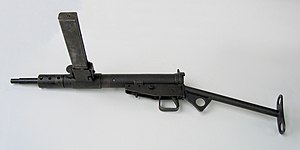Sten gun
| Sten, Submachine gun | |
|---|---|

Sten Mk. II (trigger mechanism cover is missing)
|
|
| Type | Submachine gun |
| Place of origin | United Kingdom |
| Service history | |
| In service | 1941–1960s |
| Used by | See Users |
| Wars |
World War II Warsaw Uprising Second Sino-Japanese War Chinese Civil War Indonesian National Revolution Malayan Emergency Korean War Mau Mau Uprising Suez Crisis 1948 Arab-Israeli War Sino-Indian War First Indochina War Vietnam War Laotian Civil War Lebanese Civil War Rhodesian Bush War Turkish invasion of Cyprus Indo-Pakistan Wars IRA Border Campaign The Troubles Punjab insurgency |
| Production history | |
| Designer | Major Reginald V. Shepherd Harold J. Turpin |
| Designed | 1940 |
| Manufacturer |
Royal Small Arms Factory Enfield BSA ROF Fazakerley ROF Maltby ROF Theale Berkshire Lines Brothers Ltd Long Branch Canada (plus numerous sub-contractors making individual parts). Various Underground Resistance Group Factories. |
| Produced | 1941– (version dependent) |
| No. built | 3.7–4.6 million (all variants, depending on source) |
| Variants |
Mk. I, II, IIS, III, IV, V, VI Unit Cost $10 or £2.3 in 1942 |
| Specifications | |
| Weight | 3.2 kg (7.1 lb) (Mk. II) |
| Length | 760 mm (30 in) |
| Barrel length | 196 mm (7.7 in) |
|
|
|
| Cartridge | 9×19mm Parabellum |
| Action | Blowback-operated, Open bolt |
| Rate of fire | version dependent; ~500-600 round/min |
| Muzzle velocity |
365 m/s (1,198 ft/s) 305 m/s (1,001 ft/s) (suppressed models) |
| Effective firing range | 100 m |
| Feed system | 32-round detachable box magazine |
| Sights | fixed peep rear, post front |
Mk. I, II, IIS, III, IV, V, VI
365 m/s (1,198 ft/s)
The STEN (or Sten gun) was a family of British submachine guns chambered in 9×19mm and used extensively by British and Commonwealth forces throughout World War II and the Korean War. They were notable for having a simple design and very low production cost making them effective insurgency weapons for resistance groups.
STEN is an acronym, from the names of the weapon's chief designers, Major Reginald V. Shepherd and Harold Turpin, and EN for Enfield. Over four million Stens in various versions were made in the 1940s.
The Sten emerged while Britain was engaged in the Battle of Britain, facing invasion by Germany. The army was forced to replace weapons lost during the evacuation from Dunkirk while expanding at the same time. Prior to 1941 (and even later) the British were purchasing all the Thompson submachine guns they could from the United States, but these did not meet demand. The Americans entry into the war at the end of 1941 placed an even bigger demand on the facilities making Thompsons. In order to rapidly equip a sufficient fighting force to counter the Axis threat, the Royal Small Arms Factory, Enfield, was commissioned to produce an alternative.
The credited designers were Major R. V. Shepherd, OBE, Inspector of Armaments in the Ministry of Supply Design Department at The Royal Arsenal, Woolwich, (later Assistant Chief Superintendent at the Armaments Design Department) and Mr. Harold John Turpin, Senior Draughtsman of the Design Department of the Royal Small Arms Factory (RSAF), Enfield. Shepherd had been recalled to service after having retired and spending some time at BSA.
...
Wikipedia
